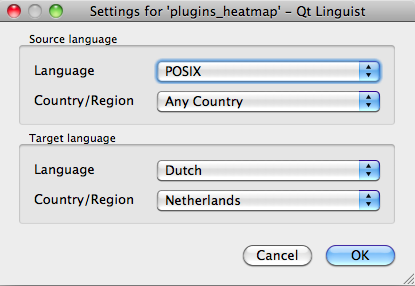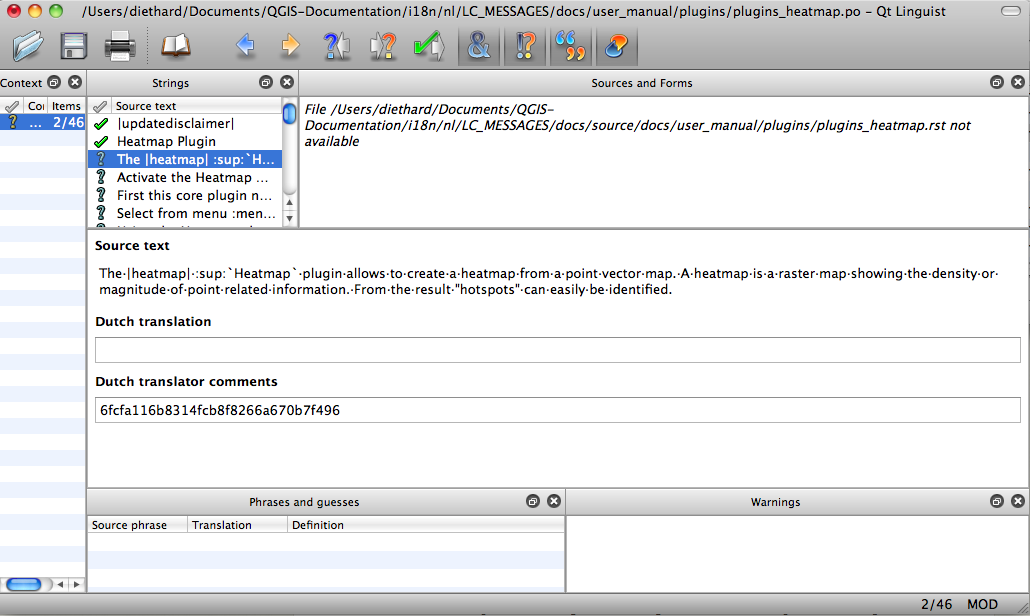Recommandations pour la traduction¶
This manual is aiming to help the translator. First the general process of how technically a translation is done is explained. Later the translation is explained from an actual English rst document that is translated to Dutch. Finally a summary of “Rules of translation” is given.
Foreword¶
A first important note: If you want to translate content within the docs folder (not web), never do this in the master branch. For translations there are always translation branches available, once a document is fully updated in english for a certain version. As an example the branch to translate the manual of QGIS 1.8, you have to use the manual_en_v1.8 branch. For questions, please contact the qgis-community-team at http://lists.osgeo.org/mailman/listinfo/qgis-community-team.
General information¶
Pour expliquer le fonctionnement de la traduction, nous allons prendre l’extension “Carte de chaleur” pour exemple. Dans cet exemple, nous traduirons de l’anglais vers le néerlandais mais c’est pratiquement la même démarche pour d’autres documents, dans toutes les langues.
First translation¶
To create documentation first rst documents are created. A prebuild script creates translation files named .po files for the english language in the folder /QGIS-Documentation/i18n/en.
Ces fichiers “originaux” sont copiés par le script dans les dossiers i18n des autres langues.
The sentences in the .po files needs to be translated from english to the language with a translation tool editor. There is a web translation tool called pootle we would like to use, but it is not activated yet. However there is an excellent tool supplied with the qt development tools named Qt Linguist.
When you want to contribute, first get a .po file and add translations for the sentences in the .po file.
When you are finished the .po file is placed back in the right place and during the next build the buildscript now creates .mo files next to the .po files.
These .mo files are actually used by the script to create translated output.
Update translations¶
When afterwards an rst document is updated a new .po file is created in the english part. The contents of this new file will be merged with already existing .po files for each language. This means that when a new line is added to an rst document that was allready translated, only the new/updated sentences are added in the translated .po file and needs to be translated. The amount of work for updating translations for next versions of QGIS should be relative small.
Translate a .po-file¶
For this example we will use the relative smaller rst document for the heatmap plugin. The source of the document can be found here:
QGIS-Documentation/source/docs/user_manual/plugins/plugins_heatmap.rst
Pourquoi ai-je donc choisi ce document?
Il est considéré comme finalisé pour la version actuelle. Lorsque le fichier n’est pas encore complet, le texte suivant suivi d’une ligne vide est affiché en haut du document.
|updatedisclamer|Ceci va générer un avertissement visible dans le fichier de sortie. Il y a de fortes chances qu’une traduction initiée sur un document ayant un avertissement de mise à jour nécessitera plus tard une retouche.
Il contient également des images, des captures d’écran, des en-têtes, des références et des substitutions.
Je l’ai rédigé donc il m’est plus facile de le traduire ;-)
The build process has created the English .po file which can be found here:
QGIS-Documentation/i18n/en/LC_MESSAGES/docs/user_manual/plugins/plugins_heatmap.po
The equivalent Dutch .po file (basically a copy) can be found here:
QGIS-Documentation/i18n/nl/LC_MESSAGES/docs/user_manual/plugins/plugins_heatmap.po
Along this file you will see a tiny .mo file which indicates that it does not hold any translations yet.
Now I will grab this .po file and start translating it. During this translation session I will point out which parts (rst statements) need translation.
Traduire avec Qt Linguist¶
When you open the .po file in Qt Linguist for the first time you will see the following dialog:
Figure Translation 1:
La langue cible devrait être renseignée correctement. La langue d’origine peut être laissée sur POSIX de même que l’option Pays/Région peut être laissée sur Tout Pays.
When you press the [OK] button Qt Linguist is filled with sentences and you can start translating, see Figure translation 2.
Figure Translation 2:
Dans le menu figurent les boutons suivants, pratiques à utiliser.
The Translation Done Next button, is the most important button. If the item needs translation, you enter a translation in the text field, then hit this button. If the item does not translation just leave the text field for translation empty and also hit this button which indicates the item is done and you continue with the next item.
Le bouton Aller au précédent peut être utilisé pour aller à la traduction précédente.
Le bouton Aller au suivant peut être utilisé pour aller à la traduction suivante.
Le bouton Suivant A Faire saute sur le premier texte non encore traduit. Pratique lorsque le document original a subi des modifications et que seules quelques phrases nouvelles ou modifiées nécessitent d’être traduites.
Le bouton Précédent A Faire effectue une recherche vers l’arrière et saute sur le premier texte non encore traduit.
Traduire un manuel¶
Commençons maintenant la traduction du manuel de l’extension Carte de chaleur !
The first two items do not need translation, just push the toolbar button which considers the translation finished and jump to the next item.
When I get to the third item we see a more interesting sentence to translate:
The |heatmap| :sup:`Heatmap` plugin allows to create a heatmap from a point vector map. A heatmap is a raster map showing the density or magnitude of point related information. From the result "hotspots" can easily be identified.
- Cette phrase contient deux instructions rst :
|heatmap|Les mots entre|sont des textes de substitution et ne devraient jamais être traduits. Celui-ci sera remplacé par l’icône de l’extension Carte de chaleur !:sup:`Heatmap` `` the ``:sup:statement is a superposition statement and prints the following text a bit higher. This is used to show the popup texts that appear when you hover above the toolbar item and this may be different when it is actually translated in the QGIS application. In this case it is not!
Tous les autres textes bruts dans cette phrase peuvent être traduits !
The fifth translation item contains the :ref: rst statement that is
commonly used to refer to another section somewhere in het manual! The text
following a :ref: statement should never be changed because it is a unique
identifier!
First this core plugin needs to be activated using the Plugin Manager (see Section :ref:`load_core_plugin`). After activation the heatmap icon |heatmap| can be found in the Raster Toolbar.
In this case “load_core_plugin” is a unique reference identifier placed before an rst item that has a caption. The ref statement will be replaced with the text of the header and turned into a hyerlink. When the header this reference is refering to is translated, all references to this header will be automatically translated as well.
L’élément suivant contient la balise rst :menuselection: suivi du texte réellement affiché dans un menu de l’application QGIS ; ce texte peut être traduit dans l’application et par conséquent doit être modifié si tel est le cas.
Select from menu :menuselection:`View -->` :menuselection:`Toolbars -->` :menuselection:`Raster` to activate the Raster Toolbar when it is not yet activated.
Ci-dessus, l’élément “View –>” est en réalité traduit en “Beeld –>” parce que c’est la traduction utilisée dans la version en néerlandais de QGIS.
Un peu plus loin, nous voyons un point délicat de traduction :
The |heatmap| :sup:`Heatmap` toolbutton starts the Dialog of the Heatmap plugin (see figure_heatmap_2_).
It holds a reference to a figure figure_heatmap_2_, and like a reference
to section this reference should not be changed!! The reference definition
itself from the rst-document is not included in the .po file and can therefore
not be changed. This means the reference to figures can not be translated. When
HTML is created you will see figure_heatmap_2. When a PDF document is
created figure_heatmap_2_ is replaced with a figure number.
L’élément suivant à traduire qui contient des attributs rst est :
**Input Point dialog**: Provides a selection of loaded point vector maps.
Do not remove the stars in above line. It will print the text it holds in bold. The text itself is often text included in the dialog itself and may wel be translated in the application.
L’élément de traduction suivant contient la balise rst :guilabel:.
When the |checkbox| :guilabel:`Advanced` checkbox is checked it will give acces to additional advanced options.
The text Advanced of the guilabel tag may wel be translated in the QGIS application and probably needs to be changed!
The following translation item contains ``airports``. The apostrophs are used this to give text another textfont. In this case it is a literal value and does not need translation.
For the following example, we will use the ``airports`` vector point layer from the QGIS sample dataset (see :ref:`label_sampledata`). Another exellent QGIS tutorial on making heatmaps can be found on `http://qgis.spatialthoughts.com <http://qgis.spatialthoughts.com/2012/07/tutorial-making-heatmaps-using-qgis-and.html>`_.
This item also includes a hyperlink with a url and an external presentation. The url should ofcourse be left intact, you are allowed to change the external text “http://qgis.spatialthoughts.com” which is visible by the reader. Never remove the underscore at the end of the hyperlink which forms an essential part of it!!
Résumé des règles de traduction¶
- Do not change replacements like
|nix| - Do not change references that start with the tag
:ref: - Do not change references that end with an underscore like
figure_1_ - Do not change the url in hyperlinks, but you may change the external description. Leave the underscore at the end of the hyperlink
- Change the contents of
:sup:,:guilabel:and:menuselection:, Check if/how it is translated in the QGIS Application. - Text between Double Stars and double apostrophes often indicate values or fieldnames, sometimes they need translation sometimes not.
- Be aware to use exactly the same apostrophes of the source text.
- Don’t end the translated strings with a new paragraph, otherwise the text will not be translated during the html generation.
Conformez-vous aux règles présentées ci-dessus et la traduction du document sera réussie !


